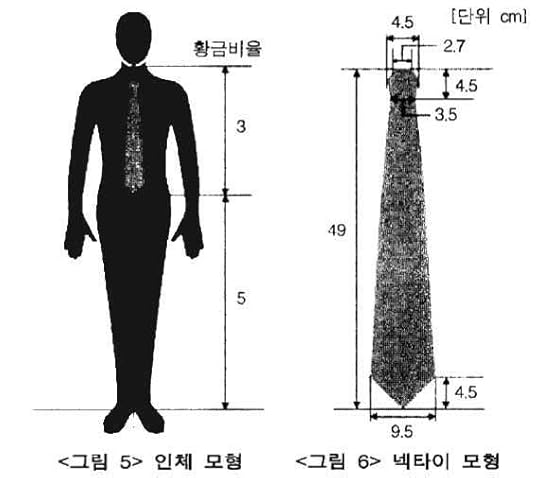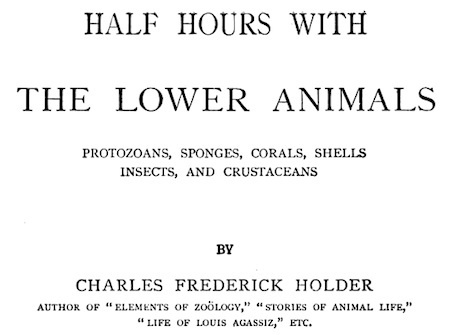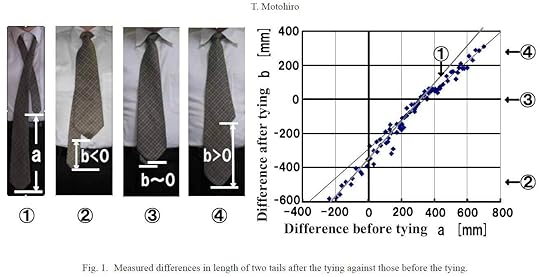Marc Abrahams's Blog, page 362
November 19, 2014
An Evening of Dramatic Improbable Readings, Wed at MIT
Join us Wednesday for… Dramatic Improbable Readings at the MIT Press Bookstore:
An Evening of Dramatic Improbable ReadingsWednesday, November 19, 2014
5:30 pm
The MIT Press Bookstore,292 main Street, CambridgePlease join us in the Bookstore for an improbable event: A Dramatic Improbable Reading performance! To celebrate his new books This Is Improbable Too and The Ig Nobel Cookbook (Vol. 1), author Marc Abrahams will dramatically read brief passages from bizarre-but-genuine scientific studies, joined by several guest dramatic readers: biomedical researcher Chris Cotsapas; science journalist Cara Giaimo; science journalist Michael Greshko; etiquette columnist Robin Abrahams; and others. If you enjoyed the Ig Nobel Lectures at MIT, you are sure to have a good time at this event.
Marc Abrahams is the Editor and Co-Founder of The Annals of Improbable Research. You may also recognize him as the Emcee of the annual Ig Nobel Prize Ceremony!
Open to the public and wheelchair accessible. Event Info: (617) 253-5249

PR headline: “Car crash survival rates increase with being younger, male and driving a big vehicle”
Today’s PR Headline of the Day appears atop a press release from Indiana University:
“Car crash survival rates increase with being younger, male and driving a big vehicle“

The effect of beer foam on resisting beer spills
Beer foam, as a subject of experimental inquiry, will be on tap at a physics meeting next week:
Abstract: H16.00009: “Damping of liquid sloshing by foams: from everyday observations to liquid transport“
67th Annual Meeting of the APS Division of Fluid Dynamics, Sunday–Tuesday, November 23–25, 2014; San Francisco, California, Session H16: Free-Surface Flows V: General, SESSION TIME:10:30 AM–12:40 PM, Monday, November 24, 2014
Authors: Alban Sauret, Francois Boulogne [pictured here], Jean Cappello, Emilie Dressaire, Howard Stone. The researchers, at Princeton University, write:
“When a liquid-filled container is set in motion, the free surface of the liquid starts to slosh, i.e. oscillate. Such effects can be observed when a glass of water is handled carelessly and the fluid sloshes or even spills over the rim of the container. However, beer does not slosh as readily, which suggests that the presence of foam could be used to damp sloshing. In this work, we study experimentally the effect on sloshing of liquid foam placed on top of a liquid bath in a Hele-Shaw cell. We generate a monodisperse 2D liquid foam and track its motion. The influence of the foam on the sloshing dynamics is characterized: 2 to 3 layers of bubbles are sufficient to significantly damp the oscillations. For more than 5 layers of bubbles, the original vertical motion of the foam becomes mainly horizontal. We rationalize our experimental findings with a model that describes the foam contribution to the damping coefficient.”
Rachel Nuwer, in Smithsonian magazine, writes about it under the headline “Physicists Explain Why Coffee Is More Prone to Spills Than Beer“:
Just as solid foam reduces noise by absorbing sound waves, liquid foam does the same for motion. The researchers discovered foam’s insulating effects by performing controlled lab experiments on coffee and beer. They used high speed cameras to record the waves of motion that rocked through the surface of coffee, an amber beer and Guinness. The more foam that was present, they observed, the more energy was absorbed and the less sloshing occurred. While the researchers found that just a few layers of bubbles were enough to make a difference for slosh, not all beers were equal in their spillage reduction.
BONUS: The 2012 Ig Nobel Prize for fluid dynamics was awarded to Rouslan Krechetnikov and Hans Mayer for studying the dynamics of liquid-sloshing, to learn what happens when a person walks while carrying a cup of coffee. They documented their research, in the paper “Walking With Coffee: Why Does It Spill?” Hans C. Mayer and Rouslan Krechetnikov, Physical Review E, vol. 85, 2012.
UPDATE: Lead author Alban Sauret emailed, informing us that co-author Emilie Dressaire’s name had been left out of the APS citation. We have added it here. Sauret (who, it turns out, attended the recent Ig Nobel Prize ceremony) also sent us these action photos from the research, which involved both coffee and beer:
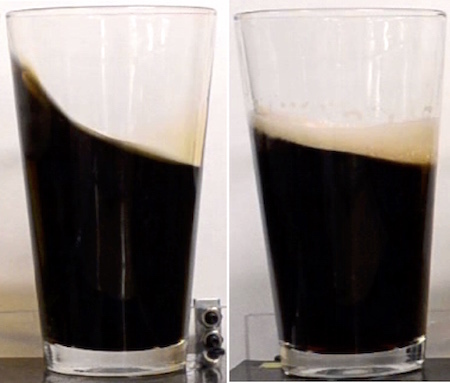


UPDATE: Here’s action video of the research.

Towards perfecting men’s necktie lengths
Following our recent improbable article on the non-linearities of Windsor Knot tying may we also recommend a paper which might be of particular interest to adult Korean males who wear neckties. Eun-Kyung Park and Jee-Won Hong presented a paper in the Journal of the Korean Society of Clothing and Textiles, Vol 27, No. 11, 2003, pp. 1198-1207. Entitled: ‘Customized Necktie Design According to Man`s Body Characteristics (part 1) : Focused on the Length of Necktie‘
“The purpose of this study was to develop customized necktie design according to Korean adult male’s body characteristics. For this purpose, experimentations of visual sensory evaluation on visual stimuli which show a man’s wearing various neckties were carried out. The subjects were students(n=130) majoring in fashion and design related area and experts(n=6). The data were analyzed by ANOVA, duncan test, pearson’s correlation coefficient, cross tabulation using spss pc^(+) program. Also statistic of Korean adult men’s body measurements(1997) were analyzed and used to decide appropriate necktie length according to the customer`s various height. The results were as follows: First, there were significant difference in visual sensibility on the stimuli showing 1) relative location of belt and necktie. 2) neckties with various length using golden ratio to the experimental model`s height. Therefore, the need of producing neckties with different length according to customer’s various height were verified. Second, neckties with three different length(140㎝, 145㎝, 151㎝) were suggested for the groups of 160㎝ height, 170㎝ height, 180㎝ height according to Korean adult male’s body characteristics and aspect of production.”
The full paper, with illustrations, is available here (note: predominantly in Korean)

November 18, 2014
Half Hours with the Lower Animals
Have you half hours that you know would be best spent in company lower than that with which you pretend to be accustomed? Consider, then, spending some of those half hours with lower animals.
 This book tells one man’s own such story:
This book tells one man’s own such story:
Half Hours with the Lower Animals: Protozoans, Sponges, Corals, Shells, Insects, and Crustaceans, Charles Frederick Holder, American Book Company, 1905.

November 17, 2014
Sad news: John Hoyland, father of “nominative determinism”, is gone
Very sad news. John Hoyland, my good friend and longtime collaborator, has died. John created “Feedback“, the best column in New Scientist, my favorite magazine (favorite other than Annals of Improbable Research, of course).
As a happy subscriber to New Scientist, I knew and loved John’s work, long before I met him. We began corresponding and collaborating from afar, and in either 2000 or 2001 we finally met, when my wife and I took a trip to London. John and I became fast friends. After that, our collaboration — exchanging good stories whenever one of us felt he had something best suited to the other’s magazine — grew frequent and sometimes giddy (when we ran across things that were especially juicy).
John was one of the best storytellers I ever met. Many of the stories involved John, who lived gleeful, impassioned lives in many worlds — radical journalism (that’s how he liked to describe it), music (as an organizer and a journalist), and later in his career, science journalism. He had a public quarrel, and then a friendship with John Lennon. This video shows John telling part of the Lennon saga, and then dipping into some of his vast knowledge and lovingly nurtured opinions (John had more than 39 million — I counted them! — lovingly nurtured opinions on various subjects) about music:
The “Feedback” column was and is a collection of odd factual bits about science and the people related to science. Much of it involves cracks in logic, either of people or of the universe. The blurbs in “Feedback” make readers laugh, and then think. As, I hope, do all the bits and pieces in the Annals of Improbable Research and the Ig Nobel Prizes — it’s no accident that John and I liked each other’s work and directed so much good material to each other. John was “Feedback”‘s ringleader, gathering and lightly editing the hard-to-classify bits that New Scientist‘s ace writers and readers were and are always stumbling across and sending his way.
John’s most famous creation, probably, is the phrase “Nominative Determinism“. John devised the phrase and wrote about it, in 1994:
“WE recently came across a new book, Pole Positions – The Polar Regions and the Future of the Planet, by Daniel Snowman. Then, a couple of weeks later, we received a copy ofLondon Under London – A Subterranean Guide, one of the authors of which is Richard Trench. So it was interesting to see Jen Hunt of the University of Manchester stating in the October issue of The Psychologist: “Authors gravitate to the area of research which fits their surname.” Hunt’s example is an article on incontinence in the British Journal of Urology (vol 49, pp 173-176, 1977) by J. W. Splatt and D. Weedon. (This really does exist. We’ve checked it).”
The article does indeed exist.
Here’s a , on the radio program “The World”, apparently in 2011.
Fed by an unstoppable flow of info sent in by New Scientist‘s readers and reporters, “Feedback” became the prime gathering place for news about people whose names matched up disturbingly well with their lot in life. From time to time John decided to ease up, partly for fear that Nominative Determinism items would overwhelm the page-a-week confines of “Feedback”. I was often the happy beneficiary of these periods — John would send me the best of what he could not or would not use, and I would steer it into the mix in Improbable Research.
In 2003 I began coming to the UK every March to do a series of shows with Ig Nobel Prize winners and others, as part of the UK’s National Science Week, and got to spend many happy hours and days having adventures and swapping stories with John. In 2005, I badgered John into becoming part of our show, to tell audiences about some of his favorite items from “Feedback”.
I had to badger him into it because John had severe stage fright. He said he had never really told stories in front of an audience. I was shocked, because John Hoyland truly was one of the most gifted storytellers I had ever encountered, and he was not shy about telling them to friends and anyone he might encounter. At the Ig Nobel shows, when I finally got him there, John would fidget, fret and shake before the moment came for him to step onto the stage. And then, as he started to talk, and also show pictures of some of the odd, funny things he was talking about, the audiences decided they loved what they were hearing, and loved most that they were hearing it from John.
In this video, you can see John’s talk at our Imperial College London show, on the 2008 Ig Nobel tour of the UK. John comes in a little after the 30-minute point. You’ll notice that John relaxes and begins to fly as the talk progresses:
Seeing that, you may find yourself itching to look up the word “hippopotomonstrosesquipedaliophobia“.
John remained a big part of our UK shows until two years ago, when treatments for prostate cancer drained so much energy that John felt he couldn’t fully be John in such a public setting.
Here are some photos of John on tour with us, telling about a curious road sign (sorry about the redeye effect in this photo!):
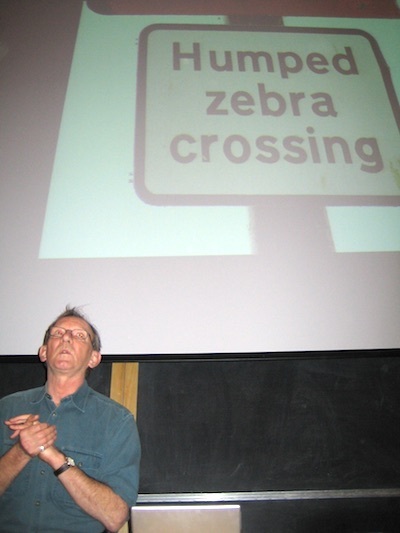
… in the audience at one of the shows, after (see how relaxed he is?) he had performed his bit on stage:
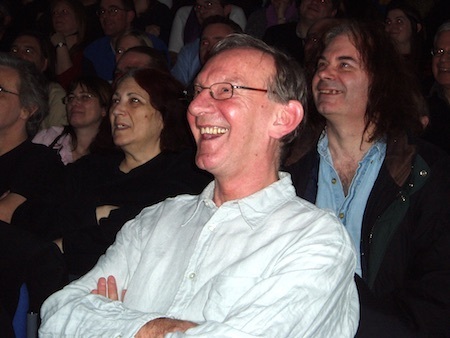
… and swapping stories and beers (the beer you see in the photo was John’s nth, I think) with us and other fellow passengers (the gent on the left here, for one) on the train back to London from the Cheltenham Science Festival in 2008:
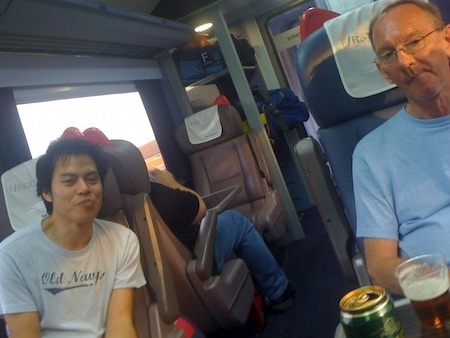
What I’ve written here describes only a few of the many great aspects of John Hoyland. I never met his like, and don’t expect I or anyone ever will. John made friends easily and quickly, pretty much everywhere he went. If you never got to meet John, you missed someone irreplaceably wonderful.

Foot and Fry on the Igs
Greg Foot and Hannah Fry, the “Head Squeeze” team from BBC Future, look at a few things that have won Ig Nobel Prizes.
They then suggest several other studies that might merit future honors. Their suggestions for non-winning papers are all things that either did win a prize or are follow-ups to things that won a prize. Here’s their video:

An Evening of Dramatic Improbable Readings, Wed at MIT
Join us Wednesday for… Dramatic Improbable Readings at the MIT Press Bookstore:
An Evening of Dramatic Improbable ReadingsWednesday, November 19, 2014
5:30 pm
The MIT Press Bookstore,292 main Street, CambridgePlease join us in the Bookstore for an improbable event: A Dramatic Improbable Reading performance! To celebrate his new books This Is Improbable Too and The Ig Nobel Cookbook (Vol. 1), author Marc Abrahams will dramatically read brief passages from bizarre-but-genuine scientific studies, joined by several guest dramatic readers: biomedical researcher Chris Cotsapas; science journalist Cara Giaimo; science journalist Michael Greshko; etiquette columnist Robin Abrahams; and others. If you enjoyed the Ig Nobel Lectures at MIT, you are sure to have a good time at this event.
Marc Abrahams is the Editor and Co-Founder of The Annals of Improbable Research. You may also recognize him as the Emcee of the annual Ig Nobel Prize Ceremony!
Open to the public and wheelchair accessible. Event Info: (617) 253-5249

A proof that glug-glug-glug the number 17
Peter Sheridan Dodds demonstrates, in this quick video, how to present something that seems like it sounds like a mathematical proof. The narrator teaches a course called “Principles of Complex Systems“, at the University of Vermont. The video is something of a randomistical bonus feature of the course:

Neckties and non-linearity avoidance
If you tie a knot in a necktie, you may have noticed that (in general) there are three major probabilities regarding the outcome. Sometimes the thin end is longer than the wide end, sometimes the wide end is longer than the thin end, and sometimes they are (roughly) equal.
In 2010, Tomoyoshi Motohiro of the Toyota Central R&D Laboratories, Nagakute, Japan, investigated the mathematical implications of such results in a paper for Forma (the journal of the Society for Science on Form)
‘A Sense of Non-linearity Originated from Form in Multiple-Folds – Tying a Necktie in Semi-Windsor Knot’ has recommendations for necktie tiers who wish to avoid non-linear scenarios.
“[...] it is obviously possible to mark a point on a tie as a function of a length around the neck by extending the analysis described here, which may ease getting a good balance of the lengths of two tails of the tie in tying. However, it is rather out of scope of this paper which tries to point out the sense of ‘non-linearity’ in our daily life in reference to the typical drift of the argument on linearity and non-linearity including the Malthus equation and the logistic equation.”
Coming soon: Towards perfecting men’s necktie lengths.

Marc Abrahams's Blog
- Marc Abrahams's profile
- 14 followers



